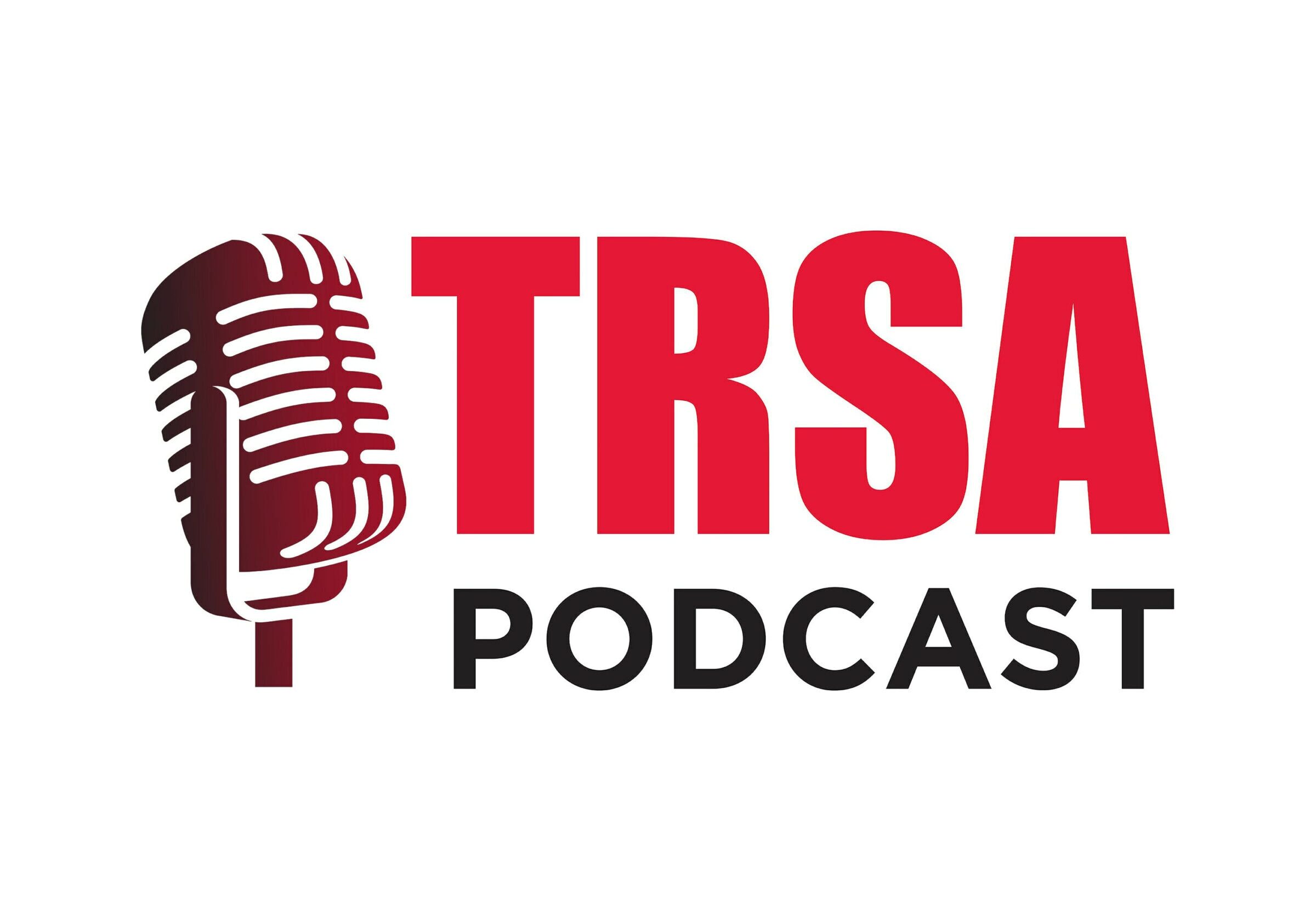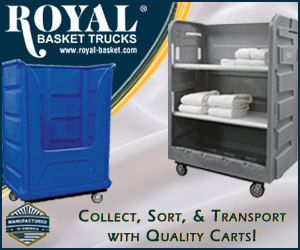Jason Pourakis and Ryan Berdnik of Mazars USA discuss best practices for negotiating with your customers, and let you know the cues that signal when it’s best to walk away from the negotiating table. For more information on the Linen, Uniform & Facility Services Podcast: Interviews & Insights by TRSA, visit our website.
Welcome to the TRSA podcast. Providing interviews and insights from the linen, uniform, and facility services industry. Most Americans might not realize it, but they benefit at least once per week from the cleanliness and safety of laundered, reusable linens, uniforms, towels, mats, and other products provided by various businesses and organizations. TRS a represents the companies that supply, launder, and maintain linens and uniforms. And in this podcast, we will bring the thought leaders of the industry to you.
I’m Jason Risley. Thank you for tuning in to the Linen Uniform, and Facility Services podcast, interviews and insights by TRSA. On today’s episode, we tackle how to handle difficult sales conversations with both existing and prospective customers. Joining us to discuss the topic are Jason Porakis and Ryan Burdnik of Mazars USA. Porakis leads Mazars accounting and advisory group and has more than 20 years experience in public accounting.
He has advised a wide range of businesses from family held companies to multinational corporations. Burdnik has more than 10 years of experience providing accounting, tax, financial planning, and consulting services to a wide range of clients, including linen, uniform, and facility services businesses. The duo will provide best practices for negotiating with your customers and let you know the cues for when it’s best to walk away from the negotiating table. So whether you’re negotiating with a new phase is an essential part to the relationship. The purpose of these discussions, really, you’re you’re setting forth the foundation and building this long term relationship.
It’s a relationship that should be profitable for both parties. Closing on a service agreement isn’t a means to an end. It’s a fresh start to the relationship. Now a common misconception of conversations around price is, you know, the amount you’re charging is an obstacle. It’s blocking the path to closing the deal.
Well, too often as sellers, one of the go to items is we’ll break down this obstacle by offering a discount to seal the deal. You know, whether a discount is something you’re regularly offering clients or if it’s a a a back pocket tactic that’s desperately used to close a deal, it’s important to constantly remind yourself that discounts just to win new business erodes your profitability. So it it as you’re going through your client pro formas and you’re, you know, you see, like, okay, maybe my margin’s a little close here. I’m I’m going by feel. This may or may not be a good relationship.
Just know the that might be the nail in the coffin is offering discount that you can’t afford. On top of that, discounts are always gonna lead to recurring problems down the road. If you close a deal with a discount this time, you know, what’s gonna happen the next time you need to renew a service contract with that same customer? They’re gonna want another discount. And that’s gonna continue on perpetuity throughout the relationship.
You know, once once you give them that discount, once it’s gonna be there, basically, the bargaining power going forward to you to keep seeking that discount from you. Now there’s several tactics to negotiating pricing conversations that can be used to overcome discounts. We’ll touch on a few of the most relevant ones. But before we get into the pricing Preparing that customer pro form a is a starting point to get you thinking about these costs that are Preparing that customer pro form a is a starting point to get you thinking about these costs that are gonna be incurred. Once you have confidence in the cost, you could base your sales price around your desired profit margin.
Knowing, your specialties, your ideal clients, what’s the bread and butter of our company? You know, are are are we, are we offering a white glove service? Are we reliable? Do we have high quality rentals? What type of customers do we best serve?
Know your value. When you’re closing on a sale, there there’s 3 things you need to to convince the buyer. You need to sell the service itself, you need to sell yourself, you need to sell the company. So oftentimes, the buyers coming to you, you know, that they need the service, So you need you to show the value of why your service differentiates yourself from the competitors. You also have to sell them on yourself.
You know, if if your thought of, you know, as the, the head of this organization, those people under you, based on the tone of tone at the top approach, they’re gonna be basically representatives of how you act and how you conduct your business. So if you’re not representing yourself as best you can, it’s not gonna be an an accurate reflection of how the customer perceives your entirety of your business. You need to sell your company. You know, there’s there’s many ways to do this, but maybe, you know, corporate sustainability is one of the hot topics these days. You know, what what is your company doing to, better promote, healthier environment?
Things of that nature. So what experience how long have we been operating in the industry? How are we perceived by our clients? What’s our reputation? How can we benefit the customer?
How can we make this a mutually profitable relationship? So when we know our costs, we know our specialties, we know the value, we start to build our confidence. Now the confidence in our abilities alone, it won’t help us negotiate effectively or close a deal if we aren’t the buyer’s number one choice. That that’s the starting point. If we aren’t the buyer’s number one choice, we need to revisit our our sales process and make sure we get to a point where we are the number one choice.
You know, as it stands, if right now you’re not the buyer’s number one choice, they’re probably just using your quote to drive down the price, for one of your competitors, the person that they’re gonna go with. The probability of closing on a contract at a premium price, it’s slim to 1 if you aren’t number 1. So if you’re not the number 1 person in mind, you’re not gonna get that premium price you desire. Just to add that I think it’s not wrong for you to straight up ask the customer or the prospect if you’re their number one choice. I couldn’t agree more.
This you know, it it’s supposed to be, you know, a meaningful conversation. You know, we’re not not supposed to be, a confrontation or at all. It’s just 2 people talking, so it’s okay to ask questions like that because it’ll help you understand what it is you could be do better and who it is you’re competing against. Demonstrating or articulating, how you’re the least risky choice of your competitors. No one wants to be a partner with a company that will create risk or jeopardize the smooth operations of their business.
You need to, convey the to the buyer your track record for pro providing this reliable and dependable service. You know, if you’re missing deliveries frequently, it doesn’t look good. You’re creating risk for your client or customer. You know, they’re not gonna be able to service their very own clients if you’re not meeting, their demands. Business decision.
There’s, who have we been discussing the terms of your sales contract with? Are they an appropriate person that has the authority to execute on these service contracts? You know, if you’re in conversations with multiple multiple people at different levels of the organization, you can’t be sure your message is being clearly communicated to the right person. Oftentimes, people will go back to their boss and just summarize the conversations you had with them, and they didn’t really deliver the clear message or portray the accurate value that you have to to provide your clients. Now for a brief message from TRSA.
Hey. Hey, my TRSA friends. I hope you have already blocked off your calendars for October 10th through 12th for this year’s 110th TRSA annual conference. Yes. That’s right.
You, me, and a few hundred of our linen uniform and facility services professionals are getting together in Naples, Florida for 3 amazing days. Now, sure, you’ll have the opportunity to connect and network with the industry’s biggest and brightest people. And of course, the event will be packed with industry insight and new leadership possibilities that that are tailored and designed to help transform your business. Oh. Oh.
And you you bet. There will be an opportunity to celebrate the year’s award winning achievements. And because you’re in Naples, you’ll have the chance to experience the wonderful sun and sand that Naples, Florida has to offer. But here’s something you haven’t had the opportunity to experience since 1913. Yep.
I just got off the phone with Joe Ricci, and he’s put together a fantastic lineup for this year’s event. First of all, NBA legend, Walter Bond will be kicking things off on October 11th in a session you are not going to want to miss. And, yes, for the first time in a 110 years, I’ll be joining the t r s a annual conference. Yes. That’s right.
We are going to dive deep into the cube of creativity. I am going to break down the 4 simple constraints you can add to any project or initiative to come up with better, more creative ideas, faster ideas that have the potential to transform not just your business, but the entire industry. So book your flights, reserve your room, and I will see you October 10th through 12th for this year’s 110th t r s a annual conference in Naples, Florida. It is time to start thinking inside the box. I’ll see you there.
Now back to the episode. Next one here is clearly identify, pricing tiers. Transparency is imperative. Right? You transparency builds trust.
Buyers will walk away when they fear the fine print of a contract. You wanna make sure you’re being as upfront as possible and having a meaningful conversation and just being completely clear about the cost. You know, the buyers never wanna feel like they’re they’re getting hoodwinked or have any kind of buyer remorse should they pursue a contract with you. The more transparent you are, higher level of trust you’re gonna build. As a seller, you know, be upfront about any kind of price adjustments that would have to be made for these, special requests, anything that occurs outside your service agreement.
So be clear about that going forward. Never give without getting. It it brings us back to the to the original problem I mentioned about giving, discounts. So when we offer a discount to our price, we’re discounting the perceived value of the service that we’re offering. It reduces our bargaining bargaining power now and in the future.
Low cost to you, but a high value to the buyer is is a nonmonetary trade up that you can offer. A price discount is gonna end up costing your company a lot more in the long run. When you’re the buyer’s number one choice, the ball’s in your court that allows you to stand by this price premium that you’re offering. Now be prepared for a price squeeze at the item level. You know, buyers are gonna attempt to squeeze you on the price almost every time.
Refocus the conversation as to why the company is the best solution to meet their needs. Once you know the cost of the additional items and desired profit margin, you could stand by to your client or prospect. You gotta stand firm on that price knowing it’s necessary for the company to to maintain its value, be profitable over the long run. Keep in mind, the buyer’s job is to get the lowest price possible. So don’t be surprised if they persist that multiple attempts to to continuously get you to drop your price.
The tactic there is to refocus the conversation as to why you are their number one choice, the value that you have to offer, the value that no other competitor can provide to them. And, hey, sometimes it comes down to walking away. You can’t be afraid to walk away. If you get to the point in this negotiation, this is when you know the opportunity is not the right one for you. You know, maybe you didn’t vet the prospect or they didn’t really meet the qualifications to to be to be a client or customer of yours.
You’re you’re gonna have to be confident in, all you’ve done. You gotta make sure you’ve talked to those right people, the decision makers. You need to make sure that you’ve represented yourself as the least risky approach. And then if you if you still can’t get the price that you’re you’re shooting for, it it’s time to walk away. In terms of difficult conversations and walking away, you know, it’s it really comes down to just being kind, communicating your business decision to walk away, why it’s not gonna work for you.
And, you know, just because you didn’t land the contract this go around, it doesn’t mean you won’t have an opportunity later down the road. You know, if the buyer is going around to your competitors, it might eventually be clear to them that, hey. Or maybe your, company was the right choice. Let’s kind of revisit this and reiterate these discussions. Make sure you know why the exact reason you could not reach an an agreement or close on this service agreement for the price you want.
You know, you don’t wanna be left knowing, okay, I went through this whole process. I’m not exactly sure why I couldn’t close or get the price I need. So just as Jason suggested, you know, make sure you know who the number one opportunity is. Make sure you know why you couldn’t close on the deal after the end of all of these discussions. So, Ryan, this is one of the hardest things that all business owners, including myself, have to come across.
Right? Especially when you’re negotiating with a with a customer that’s been with you for many years. But making that decision, like you said on, you know, where the it has to be a win on both sides. You You need to think about your business. Right?
So just adding more volume into your plan at the pricing that doesn’t accrete to the business makes no sense. So you really need to know, okay. This is where I can wiggle. This is where I can bend. But if I can’t get to this level of profitability, then I we we can’t service you as a custom.
But I think it’s important, like you said, because I’ve seen it in this industry a lot, is that, you know, while it’s a big industry, it’s a small industry, and there are a lot of boomerang customers. They leave you. They go to another textile rental company. They’re not quite getting the service, and they expect that they’ll be back within the next contract cycle. If you’re not their first choice, you know, it’s not necessarily a cue to walk away, but it is a cue to decide, okay.
Am I gonna restart my selling strategy to the to the client? Am I gonna start back from the beginning? Am I gonna reiterate my value to them to get myself to be that number one choice? Abusive, to your delivery team, you don’t want any kind of clients or customers that are gonna be abusive to any members of your organization. You know, it’s it just shouldn’t be stood for.
It’s gonna create a toxic environment inside your company, and that’s that’s definitely a cue to walk away. If they do not see you as a valued adder provider of services and are solely focused on the lowest price possible, there’s not much that can be done there until they change their mindset. Okay. You know, by not receiving a valued or quality service from you, I’m just providing the cheapest product, which I then relate to my customers. Their customers aren’t gonna be happy with them in the long term.
So it it’s just not a feasible approach for you to take on a, client with that mindset. Yeah. So just a very high level recap. You know, I think that the conversations start well before the conversation is had, and really getting that level of confidence and understanding of your costs and who you are as a business to drive the value proposition is what gets you 75% of the way. Last 25% is really the negotiation.
But once you have your level of confidence as to where you need to be and want to be from a negotiation standpoint, you’re probably that much further ahead than the customer or the prospect. Like, they may have a reason saying, I need to be at x or y, but you’re gonna give them all these compelling reasons as to why you and your business is the right match along with the pricing strategy. Today’s episode featured a sample of a recent TRSA webinar titled Difficult Conversations, Firing Unprofitable Customers. If you’d like to view the slide deck from the presentation, send an email to podcast attrsa.org. That’s podcast attrsa.org.
Thanks again for tuning in. And if you liked what you heard on today’s show, please subscribe, rate, and review us on Apple Itunes and Google Podcasts. For the latest news and information from the linen, uniform, and facility services industry, subscribe to our newsletter, Textile Services Weekly, and our monthly print publication, Textile Services Magazine. Additionally, don’t forget to follow TRSA on Facebook, Instagram, LinkedIn, and Twitter.
Publish Date
August 31, 2023
Runtime
17 min
Categories
Sign Up For Our Newsletter
Receive the latest updates on the linen, uniform and facility services industry from TRSA delivered straight to your inbox.









